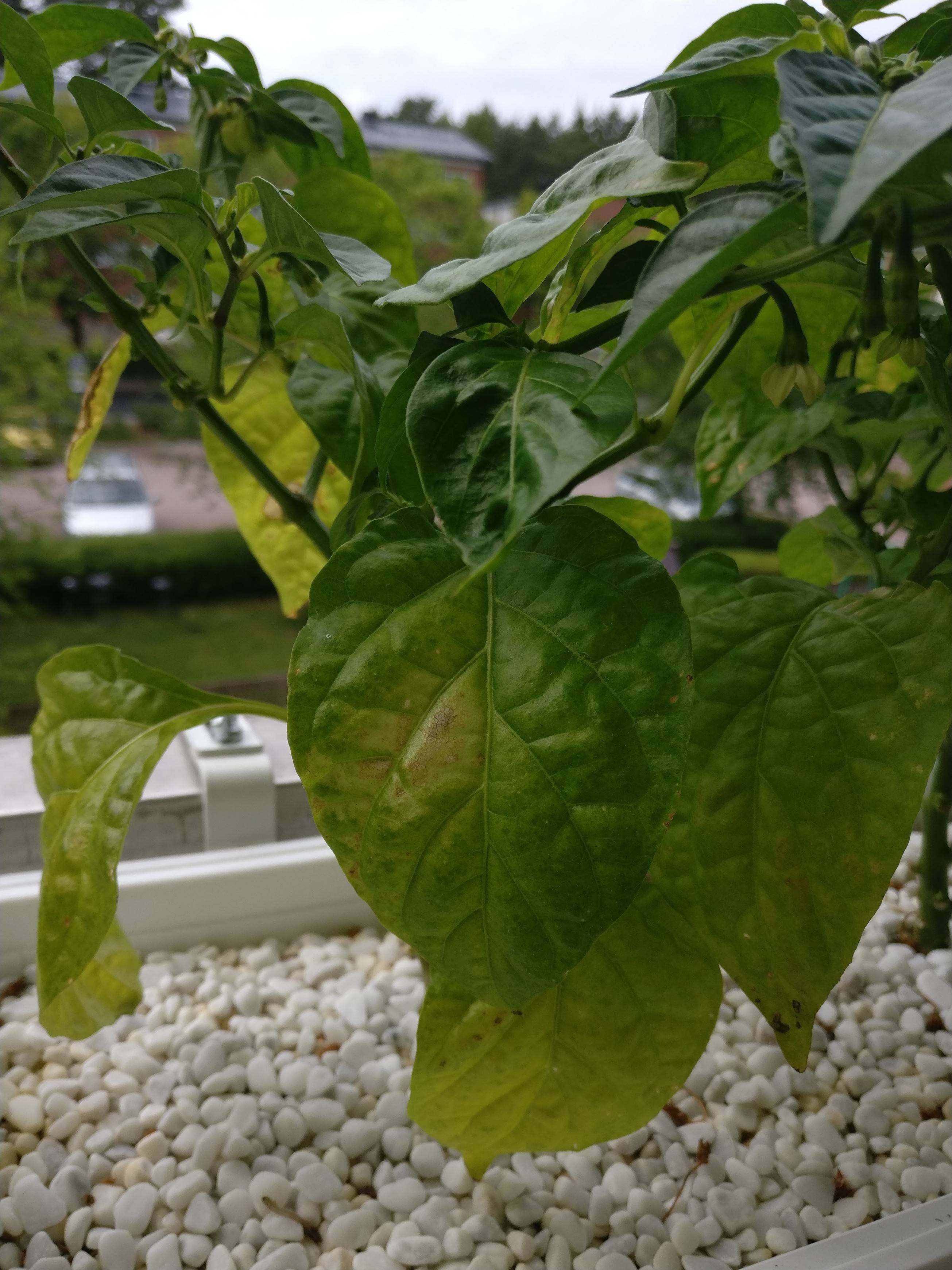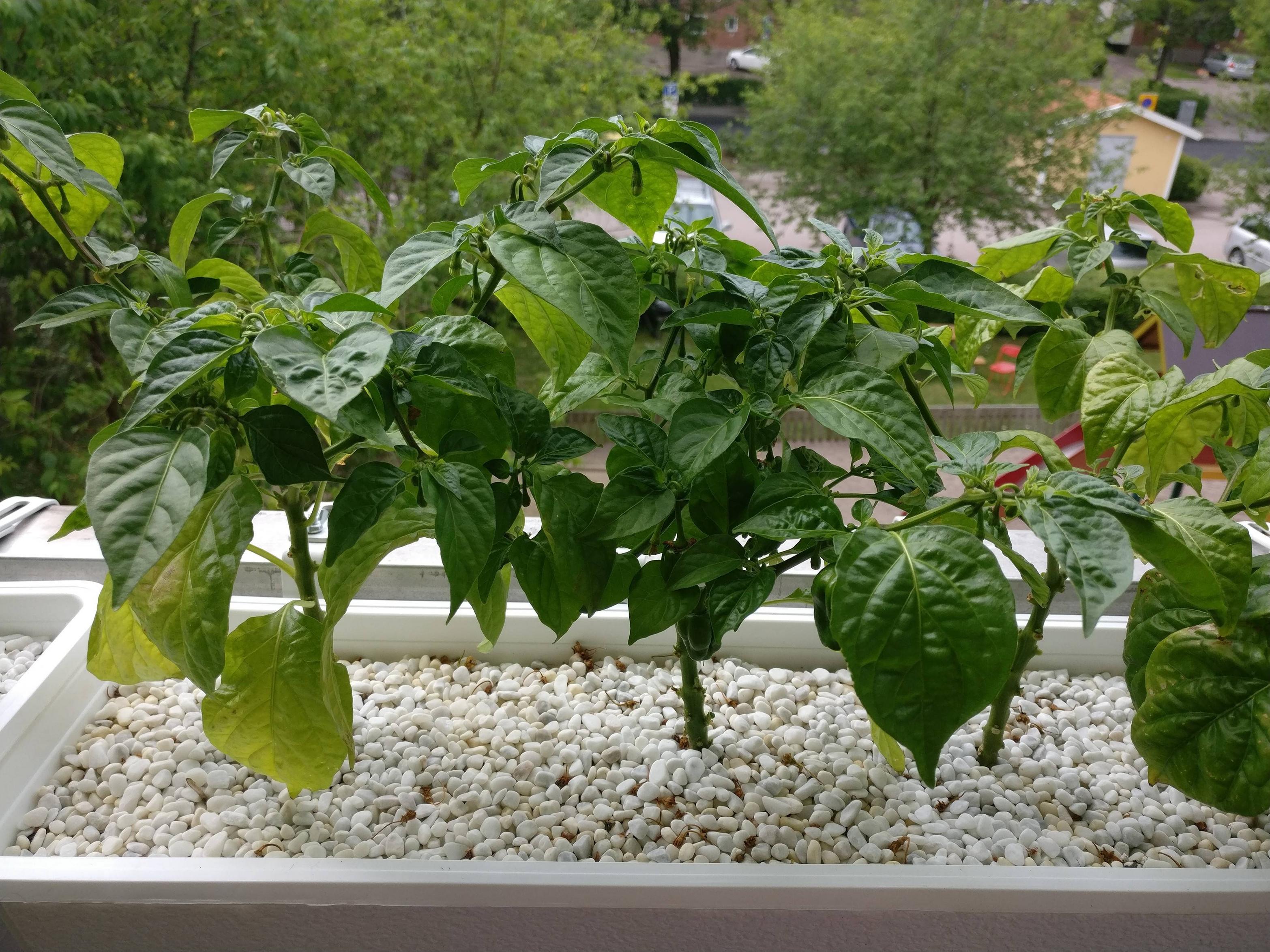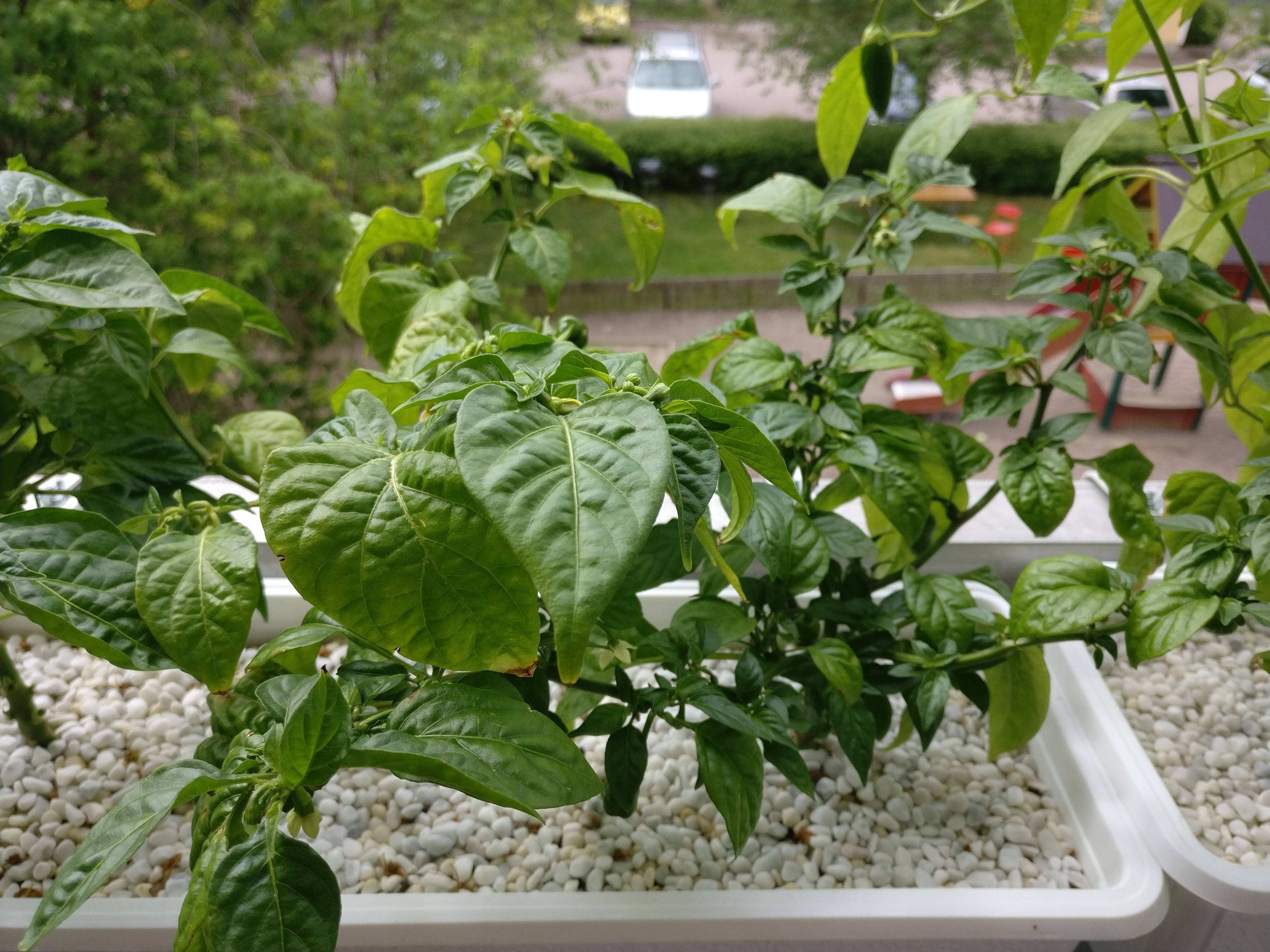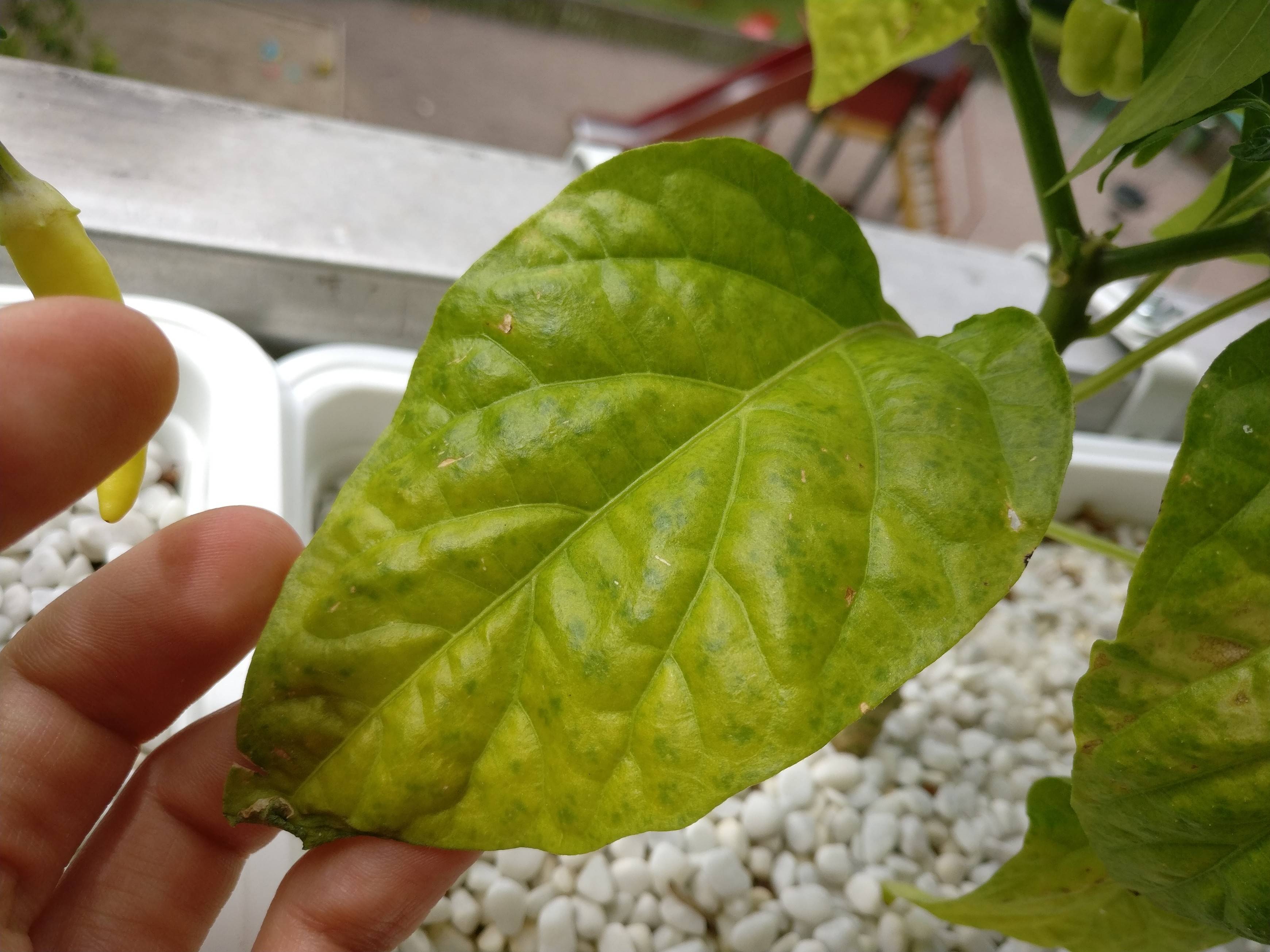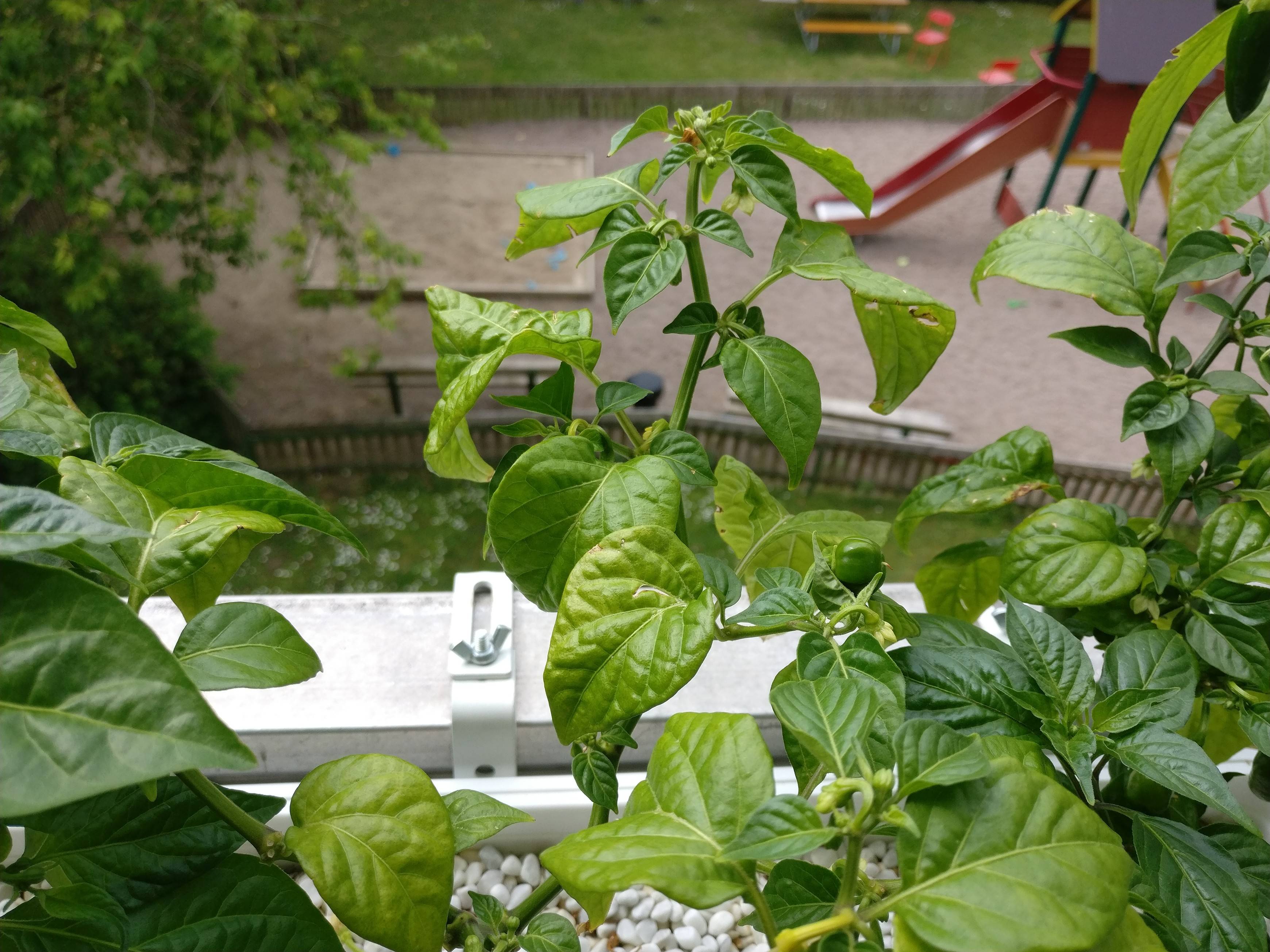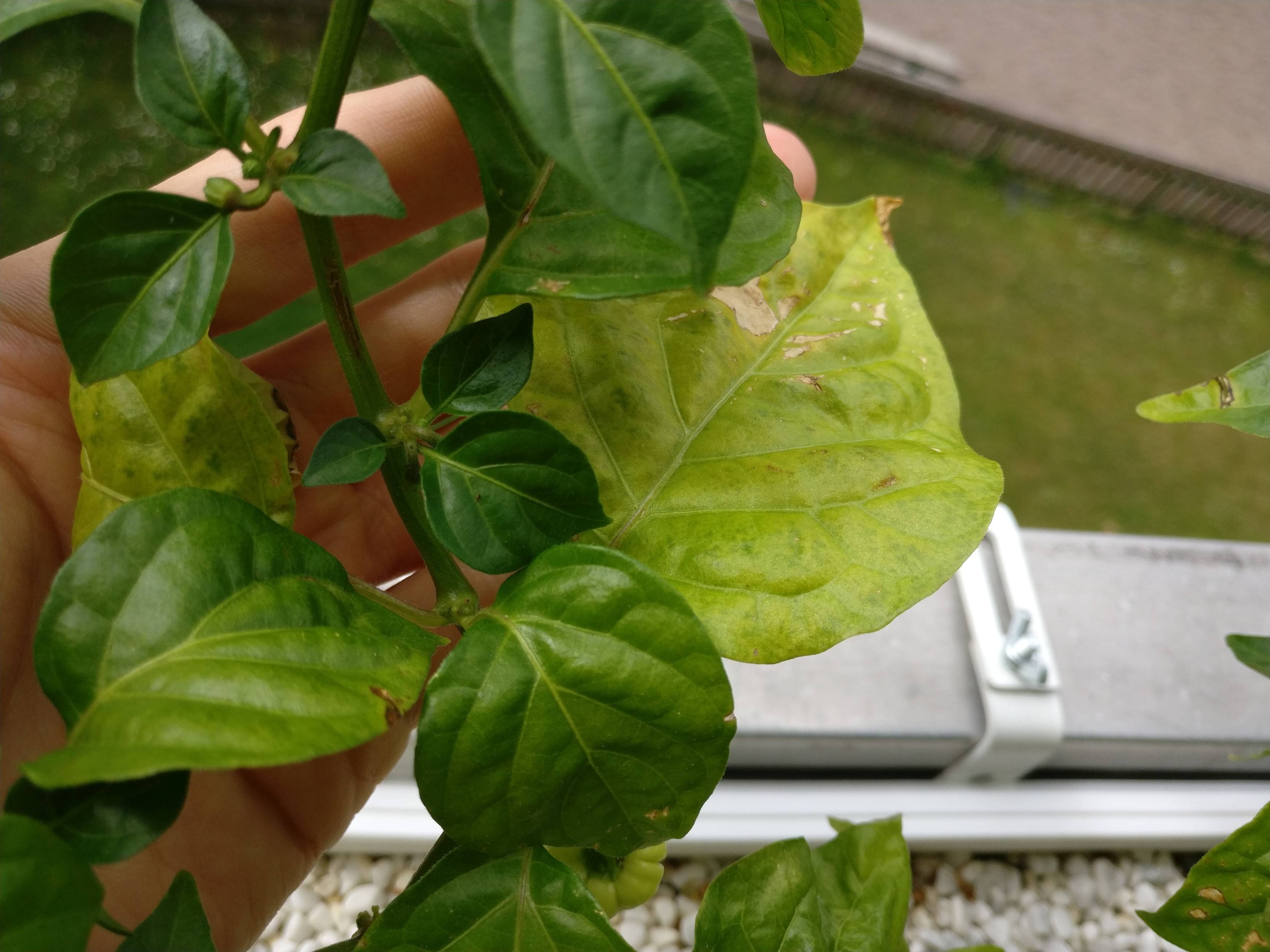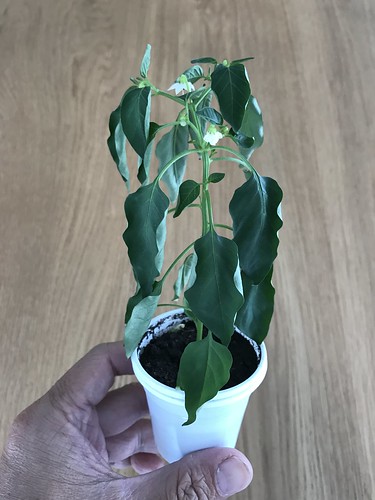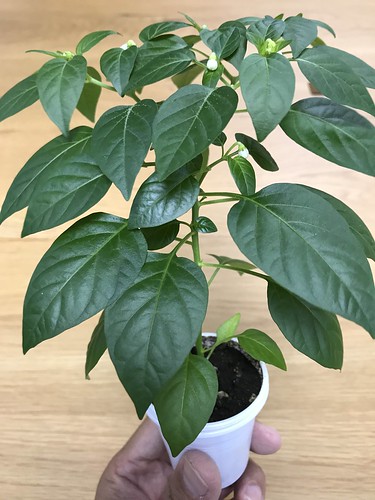Hi all, old reader but new user here!
So this year has been our first try at growing some peppers (and some bell peppers): padrón peppers, purple cayenne, thai super chili F1, ghost pepper and some unknowns. We now have fast interveinal chlorosis and a thrips problem.
Some background (might or might not be relevant):
We started under grow lights inside (proper custom IKEA cupboard build) during winter season (summer is short in Sweden) and moved out when we got decently long periods over >10°C. They are located in large balcony boxes with soil meant for roses (recommended by Swedish chili grower; not quite as acidic as most Swedish peat-based soil types) mixed with ~10-12 % vermiculite (retain some nutrition and minute water) and ~18-20 % perlite (improve airing and draining). All soil is completely covered by a thin layer white plant-ornamental stones (pretty, holds down perlite from floating up when watering, and gives some nice sun light reflection). They've been fed with Chili Focus (3:1:4.4 NPK plus all micro/traces, even inc. 1.57 % w/v Ca) and foliar feeded with epsom salt once before (~1 % v/v + dish soap, 6-8 weeks ago maybe).
When they were young we had many problems with thrips as well as all new leaves becoming deformed (possibly thrips and/or Ca deficiency due to worse, peat based soil). We treated this with frequent application of organic pine based soap (soap is a salt of potassium, not sodium) at 1-2 % v/v and once or twice with horticultural (light, summer) oil and this new nutrition. The oil they didn't like but recovered. The soap has never been a noticable issue before and killed of the thrips quite efficiently. They got very stunned by the thrips (and possibly the oil), delayed a couple of weeks/months but finally grew and are now outside.
The problem (soap treatment and yellowing leaves):
We got the thrips back. They had managed to do some unfortunate damage before proper detection and a soaping was in order (first one in 3 months or so). Usual 1 % v/v soap was applied 3 days ago and some unfortunately got in soil (more difficult to avoid when they're large and in huge boxes!), but we tried to be careful. No wash-off. Yesterday we noticed some fast yellowing of the older leaves, it looks vaguely like interveinal chlorosis (veins are more green but not really "strikingly green") with some fall-off. We've had gradual yellowing and fall-off of older leaves before but not really cared too much since young leaves has been fine and blossoming+fruit has occurred multiple times. Stems are now however getting very naked on the lower part.
So we all know interveinal chlorosis, and particularly a pattern spreading from the oldest leaves and upwards is a (possible) sign of magnesium deficiency. Furthermore I found this guide (haifa-group.com), which I quote on Mg deficiency (my emphasis):
Is Common on pepper plants. Yellowing of the leaves is apparent in the interveinal areas and veins remain green. The oldest leaves are affected first. Sometimes magnesium deficiency occurs when excessive applications of potassium have been made. It may also show up under extremely hot dry weather.
This combined with the soaping (which definitely contains potassium) seems like a likely culprit, or is it far-fetched of me? Furthermore the nutrition, "Chili Focus", doesn't mention how much Mg it contains; Likely because it's only in the minute amounts that are actually necessary (being a micronutrient and all). Since soaping will lead to foliar absorption of potassium (focusing the problem at the problem site?) and some even went in the soil, I'm seeing a possible problem of Mg lockout here. Oh, and Swedish hot weather is... not extreme.
Current action (epsom salt foliar application + more light hours):
Yesterday we sprayed all leaves with ~0.8 % v/v epsom salt solution (~½ tablespoon/quart), which is pure MgSO4 for those who've not heard of it, and a very minute drop of dish soap (as wetting agent) to try to counter this wild hypothesis via a mega-dose of Mg (it really is a mega-dose when you spray epsom salt considering how little magnesium is needed) to the problem area, and put the worst victims (bhut jolokia) on full light treatment (safe and cozy grow light during night, Swedish summer during day).
Some questions:
Please send help.
So this year has been our first try at growing some peppers (and some bell peppers): padrón peppers, purple cayenne, thai super chili F1, ghost pepper and some unknowns. We now have fast interveinal chlorosis and a thrips problem.
Some background (might or might not be relevant):
We started under grow lights inside (proper custom IKEA cupboard build) during winter season (summer is short in Sweden) and moved out when we got decently long periods over >10°C. They are located in large balcony boxes with soil meant for roses (recommended by Swedish chili grower; not quite as acidic as most Swedish peat-based soil types) mixed with ~10-12 % vermiculite (retain some nutrition and minute water) and ~18-20 % perlite (improve airing and draining). All soil is completely covered by a thin layer white plant-ornamental stones (pretty, holds down perlite from floating up when watering, and gives some nice sun light reflection). They've been fed with Chili Focus (3:1:4.4 NPK plus all micro/traces, even inc. 1.57 % w/v Ca) and foliar feeded with epsom salt once before (~1 % v/v + dish soap, 6-8 weeks ago maybe).
When they were young we had many problems with thrips as well as all new leaves becoming deformed (possibly thrips and/or Ca deficiency due to worse, peat based soil). We treated this with frequent application of organic pine based soap (soap is a salt of potassium, not sodium) at 1-2 % v/v and once or twice with horticultural (light, summer) oil and this new nutrition. The oil they didn't like but recovered. The soap has never been a noticable issue before and killed of the thrips quite efficiently. They got very stunned by the thrips (and possibly the oil), delayed a couple of weeks/months but finally grew and are now outside.
The problem (soap treatment and yellowing leaves):
We got the thrips back. They had managed to do some unfortunate damage before proper detection and a soaping was in order (first one in 3 months or so). Usual 1 % v/v soap was applied 3 days ago and some unfortunately got in soil (more difficult to avoid when they're large and in huge boxes!), but we tried to be careful. No wash-off. Yesterday we noticed some fast yellowing of the older leaves, it looks vaguely like interveinal chlorosis (veins are more green but not really "strikingly green") with some fall-off. We've had gradual yellowing and fall-off of older leaves before but not really cared too much since young leaves has been fine and blossoming+fruit has occurred multiple times. Stems are now however getting very naked on the lower part.
So we all know interveinal chlorosis, and particularly a pattern spreading from the oldest leaves and upwards is a (possible) sign of magnesium deficiency. Furthermore I found this guide (haifa-group.com), which I quote on Mg deficiency (my emphasis):
Is Common on pepper plants. Yellowing of the leaves is apparent in the interveinal areas and veins remain green. The oldest leaves are affected first. Sometimes magnesium deficiency occurs when excessive applications of potassium have been made. It may also show up under extremely hot dry weather.
This combined with the soaping (which definitely contains potassium) seems like a likely culprit, or is it far-fetched of me? Furthermore the nutrition, "Chili Focus", doesn't mention how much Mg it contains; Likely because it's only in the minute amounts that are actually necessary (being a micronutrient and all). Since soaping will lead to foliar absorption of potassium (focusing the problem at the problem site?) and some even went in the soil, I'm seeing a possible problem of Mg lockout here. Oh, and Swedish hot weather is... not extreme.
Current action (epsom salt foliar application + more light hours):
Yesterday we sprayed all leaves with ~0.8 % v/v epsom salt solution (~½ tablespoon/quart), which is pure MgSO4 for those who've not heard of it, and a very minute drop of dish soap (as wetting agent) to try to counter this wild hypothesis via a mega-dose of Mg (it really is a mega-dose when you spray epsom salt considering how little magnesium is needed) to the problem area, and put the worst victims (bhut jolokia) on full light treatment (safe and cozy grow light during night, Swedish summer during day).
Some questions:
- Is it likely we're having an acute Mg deficiency caused by (potassium salted) soap treatment?
- Can we combine epsom salt directly in the soap solution (maybe at half concentration, 0.5 v/v %) for next soaping to counter act the lockout to begin with? Some thrips are alive so we really need to soap again soon.
- Have we missed something? How could we exclude other problems?
- What else can we do?
Please send help.

